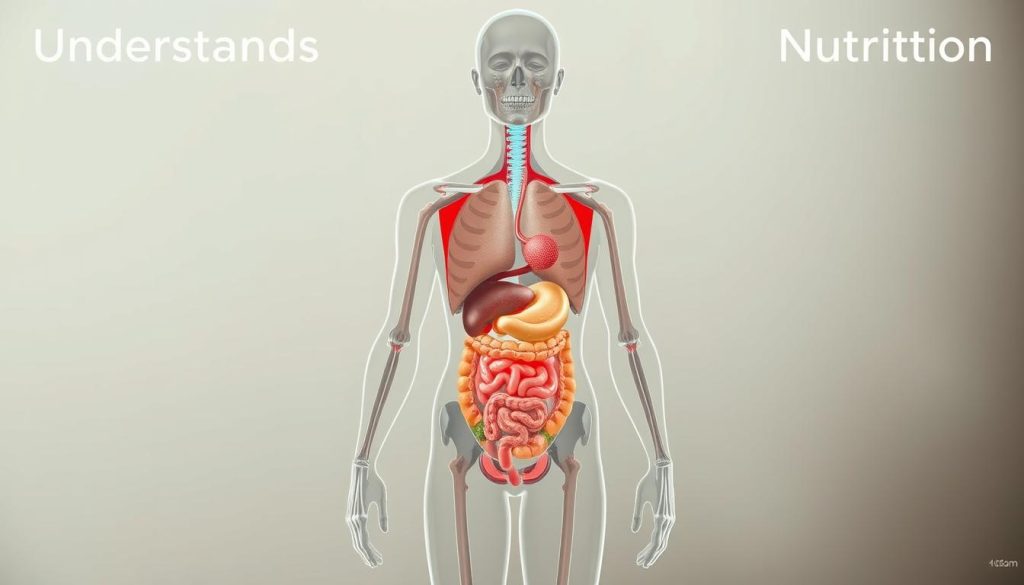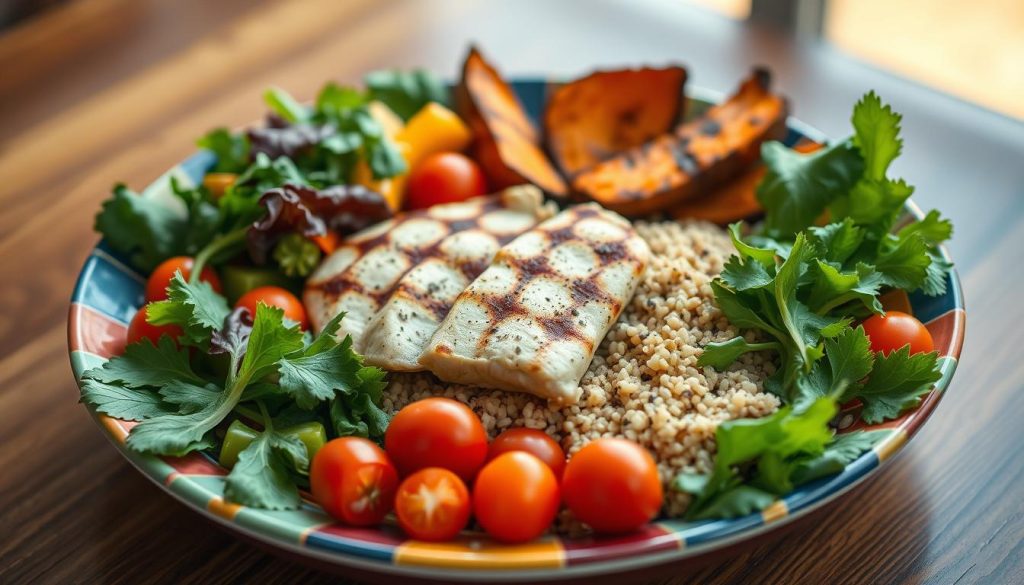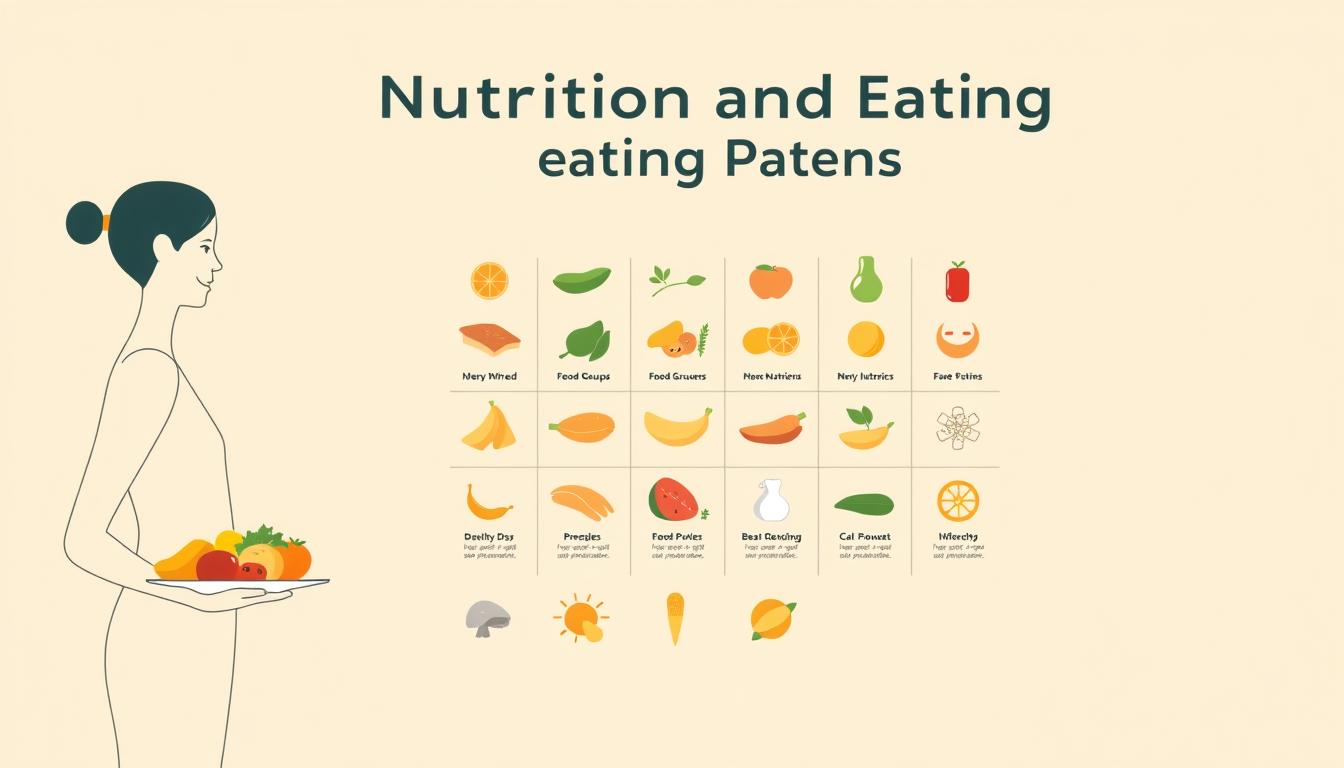Today’s world is fast-paced, making it hard to choose healthy foods. Work, family, and social life fill our days. This leaves little time for good eating habits.
With so much conflicting advice, it’s hard to know what’s best. But, knowing how to fuel your body is crucial. Our lifestyles have changed, affecting how we eat and stay healthy.
This guide offers clear, science-backed tips. You’ll learn to create diets that fit your life. No strict rules or hard-to-follow plans here.
Looking for more energy, better health, or smarter food choices? You’re in the right spot. We’ll share effective strategies for busy folks seeking lasting benefits, not quick fixes.
Understanding the Basics of Nutrition
Good nutrition starts with knowing what your body needs. Learning about food basics makes healthy choices easier. This knowledge helps you follow dietary guidelines for better health.
Your body needs different nutrients to stay healthy. Each nutrient has a special role in keeping you energized and strong. Knowing these nutrients helps you make better food choices.

Macronutrients: Proteins, Fats, and Carbs
Macronutrients are nutrients your body needs a lot of every day. They include proteins, fats, and carbohydrates. Each one has a unique role in keeping your body working well.
Proteins are key for muscle, skin, and organ repair. They also boost your immune system. Good sources are lean meats, fish, eggs, beans, and nuts.
Healthy fats are vital for hormone production and brain function. They also help your body absorb vitamins. Avocados, olive oil, and fatty fish are good sources.
Carbohydrates are your body’s main energy source. They power your brain and muscles. Choose whole grains, fruits, and vegetables for lasting energy.
Micronutrients: Vitamins and Minerals
Micronutrients are vitamins and minerals your body needs in small amounts. They are crucial for body function, even though they are small. They support bone health and immune strength.
Vitamins help turn food into energy and fight infections. Vitamin C boosts immunity, and vitamin D supports bones. B vitamins are important for your nervous system.
Minerals like calcium, iron, and zinc are vital. Calcium strengthens bones and teeth. Iron carries oxygen, and zinc aids in healing and immunity.
Following dietary guidelines ensures you get enough micronutrients. Eating a variety of fruits and vegetables gives you many essential vitamins and minerals.
Hydration: The Importance of Water
Water makes up about 60% of your body weight and is essential. It supports all body systems. It helps regulate temperature, transport nutrients, and remove waste.
Your water needs depend on activity, climate, and health. Most adults need 8 glasses a day. But, you might need more if you’re active or live in a hot place.
Good hydration signs include clear urine and feeling energetic. Dehydration causes headaches, fatigue, and trouble concentrating. Drink water all day to stay hydrated.
Knowing these nutrition basics helps you make better food choices. Understanding how nutrients support your health makes it easier to eat well every day.
Popular Eating Patterns Today
Today, we see many eating patterns that reflect current trends and habits. These patterns are popular because they are good for our health and fit well with our busy lives. Each one has its own benefits and meets different needs and tastes.
These eating patterns show a move towards making better food choices. People are leaving behind strict diets for more lasting lifestyle changes. This shift has brought us a variety of options that suit many cultures and personal preferences.

The Mediterranean Diet: Heart-Healthy Choices
The Mediterranean diet is well-studied and loved for its health benefits. It focuses on whole foods, healthy fats, and balanced portions. It’s great for the heart and can help you live longer.
It includes olive oil, lots of veggies and fruits, and fish. Whole grains, legumes, and nuts are key. Red wine in small amounts and less red meat are also part of it.
Studies show it can cut heart disease risk by up to 30%. It’s good for your brain and may prevent memory loss. This diet has become popular in restaurants and homes around the world.
Plant-Based Diets: Sustainable and Nutritious
Plant-based diets are getting more attention for their health and environmental benefits. They range from vegan to flexible plant-based eating. The goal is to eat more plants and less animal products.
They can lower disease risks, improve digestion, and help the planet. They often lead to more fiber and better weight control. Many people feel more energetic and happy.
You can start by eating meatless meals a few times a week. It’s important to pay attention to protein, vitamin B12, and iron. There are many types, like vegetarian, vegan, and flexitarian.
Intermittent Fasting: What You Need to Know
Intermittent fasting is about when you eat, not what. It’s a time-based approach that’s gained a lot of interest. There are different methods, like the 16:8 and alternate-day fasting.
The 16:8 method means eating in an 8-hour window and fasting for 16 hours. It can fit into your daily routine. The 5:2 method involves eating normally five days a week and restricting calories on two non-consecutive days.
It may improve insulin sensitivity, help with weight, and repair cells. But it’s not for everyone, especially pregnant women, kids, or those with certain health issues. Always talk to a doctor before starting.
Success with intermittent fasting depends on eating well during your eating times. Drinking water is key during fasting. Many people combine it with other healthy eating patterns for the best results.
Building a Balanced Plate
Creating nutritious meals is easy and doesn’t need fancy recipes or expensive items. The secret is knowing simple rules that fit your life. When you learn to arrange your food right, eating healthy becomes easy.
A balanced plate gives your body the nutrients it needs for the day. This method uses easy-to-follow steps that anyone can do. You’ll learn to make healthy choices without worrying about calories or measuring ingredients.
Portion Control: Serving Sizes Made Simple
Knowing the right portion sizes is easy without measuring cups. Your hands are great for guessing serving sizes. A palm-sized amount of protein is usually right for most meals.
Your thumb is about one tablespoon of fats like oils or nut butters. Two cupped hands show the right amount of leafy greens and veggies. These tips make controlling portions simple for everyday use.
Start with half your plate for veggies and fruits. Add a quarter for lean protein and the last quarter for whole grains or starchy veggies. This way, you make balanced meals without complicated math.
The Rainbow Principle: Colorful Fruits and Veggies
Eating foods of different colors ensures you get a variety of nutrients and antioxidants. Each color offers unique health benefits. Red foods like tomatoes and strawberries are full of lycopene and vitamin C.

Orange and yellow foods, like carrots and bell peppers, are rich in beta-carotene and vitamin A. Green veggies, such as spinach and broccoli, are packed with folate and iron. Purple foods, including eggplant and blueberries, have powerful antioxidants called anthocyanins.
Try to include at least three colors in each meal. This simple rule boosts your nutrient intake. Add colorful toppings to your usual dishes or mix different colored veggies in stir-fries and salads.
Meal Prep: Planning for Success
Good meal planning helps you eat healthy all week. Pick one day to plan and prep your meals. This saves time during busy weeks and cuts down on food waste.
Start by cooking proteins like grilled chicken, baked fish, or beans in bulk. Prepare ingredients that can be used in many dishes. Wash and chop veggies, cook grains, and portion snacks for easy access.
Store your prepped ingredients in clear containers so you can see what you have. Mix and match these items to create different meals. This keeps your meals interesting and nutritious.
If you like having meals ready to eat, think about making soups, stews, or casseroles. These freeze well and are great for quick, healthy meals. Label everything with dates to keep track of freshness and use your prepared foods in order.
Listening to Your Body
True nutrition success isn’t just about counting calories or following meal plans. It’s about reconnecting with your body’s natural wisdom. Your body can tell you what it needs and when. Learning to listen to these signals changes how you view eating.
Modern life often makes it hard to hear what our bodies are saying. We eat while watching TV, scrolling phones, or rushing between meetings. This can lead to overeating, poor digestion, and a strained relationship with food.
Mindful Eating: Cultivating Awareness
Mindful eating means paying full attention to your food and eating experience. It’s about slowing down and really noticing what you’re eating. This simple practice can help you enjoy your meals more and feel satisfied with less food.
Start by eating without distractions. Put away your phone and turn off the TV. Take time to notice the colors, smells, and textures of your food. Chew slowly and really taste each bite.
Notice how different foods make you feel. Some food choices might give you energy, while others might make you feel sluggish. Pay attention to these signals. Your body is giving you valuable information about what works best for you.

Try the “first bite rule.” Make your first bite of each meal extra special. Put down your fork between bites. This helps you eat more slowly and notice when you start feeling full.
Recognizing Hunger Cues: Eating Intuitively
True hunger feels different from other reasons we might want to eat. Physical hunger builds gradually and can be satisfied with many different foods. Emotional hunger often comes on suddenly and craves specific comfort foods.
Learn to rate your hunger on a scale from 1 to 10. One means you’re extremely hungry, and 10 means you’re uncomfortably full. Try to eat when you’re at a 3 or 4 and stop when you reach a 6 or 7.
Your body also sends fullness signals, but they take about 20 minutes to reach your brain. Eating slowly gives these signals time to work. You’ll naturally eat less without feeling deprived.
Trust your body’s wisdom about food choices. If you’re craving something specific, ask yourself if you’re truly hungry or if something else is driving the craving. Sometimes we eat because we’re bored, stressed, or tired rather than actually hungry.
Remember that intuitive eating is a skill that takes practice. Be patient with yourself as you learn to reconnect with your body’s natural signals. This approach leads to a more peaceful and sustainable relationship with food.
Overcoming Challenges in Nutrition
Real-world nutrition success needs practical strategies for common obstacles. Life throws unique challenges that can stop even the best eating plans. Knowing how to handle these situations is key to lasting changes, not just short-term diets.
Navigating Social Situations: Eating Out
Eating out and social gatherings test your commitment to healthy eating. Look at menus online before you go to find good choices. Tell servers about your dietary needs without feeling shy.
Choose grilled proteins over fried ones and ask for dressings on the side. Sharing appetizers or desserts lets you enjoy social times while keeping portions in check.
Dealing with Food Cravings: Strategies for Success
Food cravings are normal, often due to stress, emotions, or nutrient gaps. Drink water first, as thirst can feel like hunger. Keep healthy snacks on hand to curb sudden cravings.
Practice the 10-minute rule – wait before acting on cravings, as many fade away. Address emotional triggers with activities like walking or calling a friend.
Making Sustainable Changes: Tips for Long-Term Habits
Long-term nutrition success comes from small, realistic changes, not big overhauls. Start with one small change each week, like adding veggies to breakfast. Plan for setbacks without giving up on your goals.
Create a supportive environment by stocking healthy foods and removing temptations. Focus on progress, not perfection, to build confidence and keep motivated for a lifetime of wellness.

